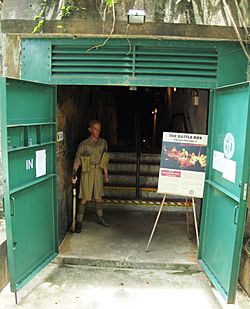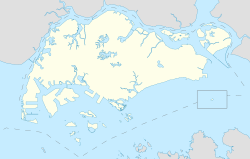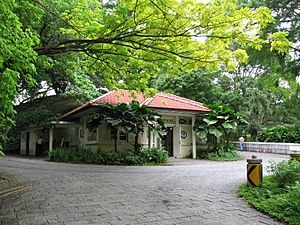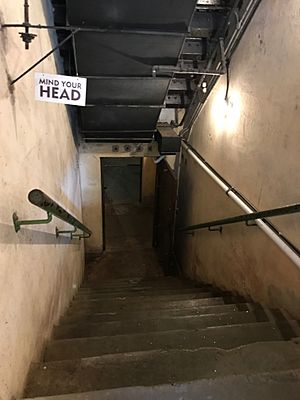The Battle Box facts for kids
Quick facts for kids Headquarters Malaya Command Operations Bunker地下指挥中心博物馆 |
|
|---|---|
| Fort Canning Hill in Singapore | |

One of the entrances to the Battle Box museum
|
|
|
Location in Singapore
|
|
| Coordinates | 1°17′46.0″N 103°50′46.3″E / 1.296111°N 103.846194°E |
| Type | bunker |
| Site information | |
| Owner | British Army (former) |
| Open to the public |
yes |
| Condition | Renovated |
| Site history | |
| Built | 1936 |
| In use | 1945 |
| Fate | Renovated into a museum |
| Battles/wars | Malayan Campaign Battle of Singapore |
| Garrison information | |
| Past commanders |
Lieutenant-General Arthur Percival |
The Battle Box is a famous underground bunker located deep under Fort Canning Hill in Singapore. It was once known as the Headquarters Malaya Command Operations Bunker. This special building was made to be a safe, bomb-proof command center. It was used during the Malayan Campaign and the Battle of Singapore in World War II. Today, the Battle Box is a popular museum and a place for tourists to visit.
Contents
History of the Battle Box
Singapore was very important because of its location in the western Pacific Ocean. The Royal Navy (Britain's navy) saw it as a key place to stop the growing power of Japan. Japan was seen as a threat to Britain's interests in Asia.
To deal with this, the British Navy planned the Singapore strategy. This plan needed a strong naval base. So, the Singapore Naval Base was built on the north side of Singapore Island. This base and its defenses needed many British soldiers to be on the island.
Fort Canning Hill was already used by the British Army as their main office in Singapore. Many buildings were put up there in the 1920s. But in 1936, a problem was noticed. There was no single headquarters for all three British forces in Singapore: the Army, the Navy, and the Royal Air Force.
Colonel Arthur Percival, a high-ranking officer, suggested building a combined headquarters. This new center would be at Fort Canning.
Building the Bunker
Fort Canning Hill is a small hill in the center of Singapore. Long ago, in 1823, Stamford Raffles built a home there. Later, in 1867, a fort was built on the hill. But by the early 1900s, other defenses around Singapore made the Fort Canning fort less important.
The Fort Canning Bunker, also called the Headquarters Malaya Command Operations Bunker, was built deep underground. It was nearly 30 feet (about 9 meters) below the hill. Construction started in 1936 and finished by 1941.
The bunker had very strong walls. They were one meter (about 3 feet) thick and made of reinforced concrete. This was to protect it from bombs and shells. The bunker had many rooms, possibly 22 or even 29.
Inside, there was a telephone exchange. It connected to all military and most civilian phones in Malaya. There were also rooms for signals and operations. The bunker had places for sleeping and bathrooms. There was even a special room for coding and decoding secret messages.
World War II and the Fall of Singapore
By 1941, the bunker was thought to be too small. Arthur Percival, now a lieutenant general, decided to build a new, bigger headquarters. This new one was at the Royal Air Force base in Sime Road. It was finished in December 1941.
Even with the new headquarters, the Fort Canning Bunker remained important. It was the main office for Major General Frank Keith Simmons. He was in charge of defending Singapore Island. The bunker also kept the Anti-Aircraft Gun Operations Room and Naval Extended Defenses offices.
The Japanese army invaded Malaya on December 8, 1941. They moved south through Thailand and landed at Kota Baharu. Allied forces quickly had to retreat to Singapore Island by January 31, 1942.
On February 8, Japanese troops crossed the Straits of Johor. They landed at the Battle of Sarimbun Beach on Singapore's northwest coast. A second landing happened near the Kranji River, known as the Battle of Kranji.
During the Battle of Kranji, the Sime Road headquarters had to be left. Lieutenant-General Percival moved his main command center to the Fort Canning Bunker on February 11, 1942.
Towards the end of the battle for Singapore, the Japanese were bombing the central area. Fort Canning Hill was hit often. Many officers and soldiers, about 500 of them, had to stay inside the bunker for safety.
The decision to surrender Singapore was made on the morning of February 15, 1942. Lieutenant-General Percival met with other senior officers in the bunker. They were running out of water and could not fight back. So, they decided to surrender to the Japanese.
After the surrender, Japanese forces used the Fort Canning Bunker. They used it for communications during the Japanese Occupation of Singapore. After World War II ended, the bunker was found to have been looted. People likely searched for hidden treasures.
The Battle Box Today
After the war, the British used Fort Canning Hill again. But the Fort Canning Bunker was left empty. It was sealed off in the late 1960s because of safety worries. Its exact location was even forgotten for a while.
In 1988, a journalist "rediscovered" the bunker. They were following clues about an underground complex on Fort Canning Hill.
The Fort Canning Bunker was then turned into a museum. It shows the story of the final days of the Battle of Singapore. The museum, now called the Battle Box, officially opened on February 15, 1997. This was 55 years after Singapore surrendered.
See also
- Battle of Singapore
- Fort Canning
- Singapore strategy




